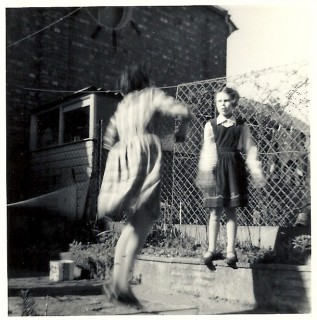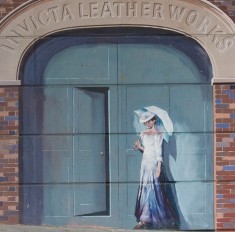
Dad concreted the central part of our garden over and made raised flower beds using bricks that he moulded himself. When we played, we could hear music floating out of Invicta’s window, the latter often being left open.
The Invicta Leather Works was a source of employment in the area for nearly seventy years but, to the residents in the lower part of Rampart Road, it was an obstruction that towered above their back gardens blocking out views and light. Nevertheless, on a fine morning, the wall that stretched from the first house to Number 18, could be a thing of beauty; the sun’s rays turning it into a blaze of crimsons, ochres and browns against the small patch of dark blue sky. Also, for children, the building had a slightly mysterious quality, the only signs of habitation being a whirring fan, music from a radio and disembodied voices floating from the open window high above number 16.
Moving to Paynes Hill in 1902 after its premises in Endless Street burnt down, the works changed hands several times before war was declared in 1939. The business, also called Colonia Ltd, was then seized and closed by the British government; its current German owners having fled the country! Invicta/Colonia returned to private ownership after the war and by 1956, eighty workers were processing the imported goat, sheep and reptile skins for shoe and fancy goods. Unfortunately, however, it was now that its relationship with its Rampart Road neighbours really began to sour, the chimney often emitting brown smuts that burnt holes in washing put out on garden lines.

The entrance to Invicta Leather Works was in Paynes Hill and it was, here, that June Hanford came with her basket of washing. She was fortunate to receive compensation as for months the management claimed that the smuts did not come from the chimney behind numbers 18 and 20 in Rampart Road. Council officials were also loath to take action, forcing residents to air their grievances on a Southern Television programme as they were also worried about the effect the emissions were having on their health. Eventually, the chimney was extended but this only alleviated the problem rather than eliminating it!
Mural picture painted by Fred Fieber and Anthony Woodward, photographed by John Palmer
Visits were made to the Council, letters written to the press and complaints aired on Southern Television, one resident, June Handford deciding to confront the actual source!
‘So they had the leather factory and of course
every now and again the leather factory send
out all this smoke and it burnt your clothes. I
put all me washing out and when I looked out
everything was covered in absolutely brown,
big spots, course it caught, they’d all gone rust
like. So there was a lot of trouble with this
firm at the back, a lot of people put in for
the money from the, through the television
and all: I so mad I picked up all the washing,
put it in the basket, went round and told em
to ‘Just look what’s happened here,’ and the
man said, ‘and how much did all that cost
you’ he paid me out there and then, where
everybody was having trouble’
Finally, the Invicta management acknowledged there was a problem and took steps to remedy the situation; one being to raise the height of the metal flue behind Rampart Road.
In 1969, the Council acquired all land and buildings in the area for the development of a dual carriageway; a Compulsory Purchase Order forcing the owners to sell. The works were demolished a year later and the rubble used as hardcore for the new road; the ghost of Invicta lingering beneath the wheels of the vehicles travelling along Churchill Way!


Comments about this page
Fascinating stuff! I love these reminiscences! I remember going round the milk factory on a school trip and feeling very queasy because of the smell of sour milk that seemed to hang in the air!
We lived in Culver Street and our back garden had the wall of the factory at the end and over the wall to the right was the notorious chimney. We also complained along with those in Rampart Road. Interestingly, the manager of the factory was the dad of my school chum a Mr Soutar.
Just the other day, my younger brother was reminding me of the times we climbed over the wall into the factory yard and took scraps of leather destined for the incinerator which we sewed into small money bags.
Living in Culver Street at that time was like living in a war zone, at least in terms of the devastation, as buildings were purchased and left empty for the development of the new road and the road to nowhere. Ours was one of the last houses left and as children we played in the milk factory when that was left empty (I fell through the roof and ended up in hospital with concussion) and we explored all the empty houses as they became vacated. I will never forget how shocked I was at how small, damp and rudimentary the alms houses at the end of the street next to Ralph’s greengrocer were with a small grate for a fire and an outside toilet. I couldn’t’ believe elderly people could live there. Many of the houses we explored were dangerous but that was what we knew. Eventually we were re-housed and went all the way to Guilder Lane where my brother still lives. I was born in Penny Farthing Street as were all my brothers and sisters except the youngest who was born in Odstock hospital.
My memories are from the last days of the old place but my siblings will have better memories going back further. I think you already have contributions from my older sisters.
As a child growing up there during that later time I probably have a different perspective. In the summer we virtually lived up the Greenie and many a time an older sister would be sent to fetch me home after playing footy or cricket late into the evening. That playground was dangerous! The rocker that we swung around on, the roundabout that we used to spin as fast as we could and see who could get on it first, the rocking horse that had a lethal buck if you got it going hard enough. We used to see who could grab the branches of the lime trees from the swings, but to do that you had to swing so high that the tension would go from the chains at the top of the swing. We were fearless. We used to play ‘splits’ on the grass with knives and if we got bored we’d always have the Council Grounds to explore. We climbed Devil’s Arch, carved initials on the wall of the entrance, build dens in the grounds and of course, rode bikes down the treacherous slopes of the rampart. The council grounds lawn was the best place to play football as the grass was looked after and it was flat. The Greenie on the other hand was used to exercise dogs – say no more.
I have a short story that links the Junk Shop and bonfire night on the Greenie. As others have recounted, we also went around collecting stuff from wherever we could for the bonfire, loading it up on buggies we made from wood and pram wheels ( we used to ride these down Kelsey Hill towards Rampart Road!). We were given a mounted stuffed turtle head. We played with it and I’m pretty sure used it as a target for stone throwing (we used to do a lot of stone throwing). I think we sold it to the Junk Shop (but I can’t be sure). Anyway found its way there one way or another and it was hung up in the shop and became a feature for many years with an enormous price tag on (to our minds). Perhaps that’s why it never got sold. Good days.
Add a comment about this page